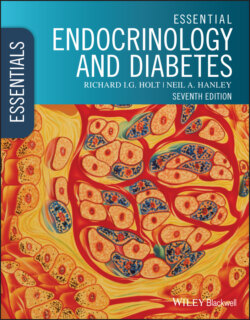Читать книгу Essential Endocrinology and Diabetes - Richard I. G. Holt - Страница 90
Immunoassays – the competitive‐binding assays
ОглавлениеIn the competitive‐binding immunoassay (shown for T4 in Figure 4.3), constant amounts of antibody and labelled antigen are added to each tube. A ‘zero’ tube is set up that contains labelled T4, as well as a tube that also includes a known amount of unlabelled standard T4. Incubation allows the antigen–antibody complex to form. Since the zero tube contains twice as much labelled T4 as antibody, half of the labelled hormone will be bound and the other half will remain free (i.e. in excess). In the other tube, unlabelled and labelled T4 compete for the limited opportunity to bind antibody. The total antibody‐bound T4 is separated (e.g. by precipitation) and the label measured (e.g. by fluorescence or radioactivity). There will be less signal from the second tube because of competition from the unlabelled T4; the decrease will be a function of the amount of unlabelled T4 added, i.e. the signal decreases as the amount of unlabelled T4 increases, allowing the construction of a calibration curve (Figure 4.3). For clinical use, standard T4 is replaced by the patient sample, with all other assay conditions kept the same. As for immunometric assays, a five to eight‐point calibration curve offers sufficient precision for patient samples to be interpolated.
Figure 4.2 The basics of an immunometric assay for growth hormone (GH; also see text). As in Figure 4.1, in practice, large numbers of molecules are present for each reagent and the incubation of the first and second antibodies is usually simultaneous. Because the hormone is bound between the two antibodies in the triple complex ( ), this assay is sometimes referred to as a sandwich assay. Separation of the complex from the excess labelled second antibody is usually achieved physically, e.g. by precipitation and centrifugation (the supernatant contains the unbound antibody and is discarded). This leaves the bound labelled second antibody to be quantified by counting radioactivity or measuring fluorescence. The low measurement from the ‘zero’ tube, Tube 1, and the higher value from Tube 2 are plotted on the calibration curve. Tube 1 is not zero because of minor non‐specific antibody binding. The calibration line is also curved, rather than straight, because of the reversible nature of the interaction between antibodies and their antigens. In practice, five to eight calibration points are used to construct the curve.
